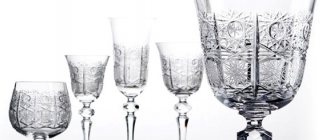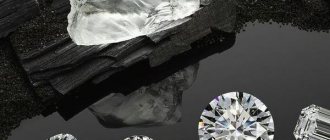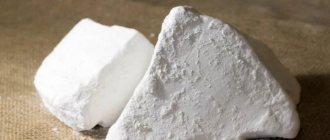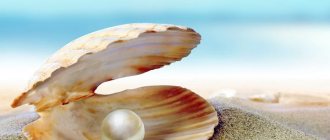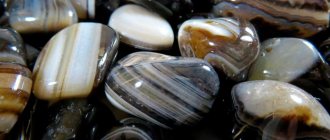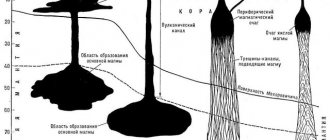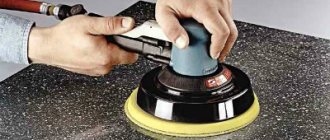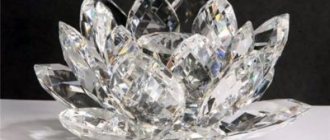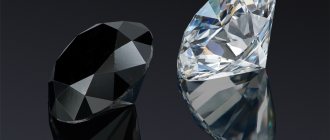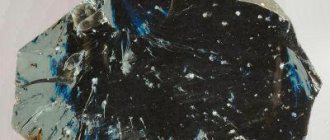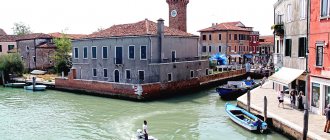Differences between crystal and glass.
It is worth noting that crystal is a special type of glass, which is distinguished by its nobility. During the Soviet Union, almost all women could distinguish crystal from glass. Now the popularity of this material has decreased slightly, due to the appearance of very high-quality types of glass on store shelves. Accordingly, now few people know how to distinguish between crystal and glass. In this article we will try to understand the main differences between glass and crystal.
What is the difference between glass and crystal: features of manufacture and composition
The main difference between these two materials is their origin. Glass is a completely synthetic material that is made by fusing sand with other components. Rock crystal is a natural material that is an analogue of natural quartz, only completely transparent.
Thanks to this, the cost of crystal products is significantly higher than the price of glass. In principle, the main difference is the cost of these products. Although it very often happens that sellers try to pass off glass products as crystal. This allows you to make a huge markup and sell the product at a higher price.
Crystal glasses
Of course, we can talk about the natural origin of crystal only when comparing ordinary glass with rock crystal. The material used to make tableware is also glass, but a special type of it, called crystal. What we use in life is not rock crystal, but lead silicate glass. It is produced using a slightly different technology.
If we compare the composition of these materials, then when making crystal, at least 17-27% lead or barium oxide is introduced. These additives make it possible to increase the angle of refraction, as well as the dispersion of materials. Thanks to this, the light in such products is very well refracted. Accordingly, crystal can be processed like diamonds, allowing it to be cut.
Crystal
Crystal
We are all familiar with this word. However, did you know that there are two types of this material: artificial or mountain?
Artificial crystal is a type of glass that contains at least 24% lead oxide. This composition was invented by the English master G. Ravenscroft in 1676. It all started with the fact that in 1615 in England it was prohibited to use wood as a material in all areas of production with the exception of shipbuilding. To keep factories open, coal was used for furnaces instead of wood. Many workers immediately noticed that at high temperatures the glass becomes completely colorless. This was followed by hundreds of experiments with mixing the components and thus the result was artificial crystal - clean, transparent, like a tear.
Crystal has 4 grades:
- Classical. It contains from 24% to 30% lead oxide.
- Low lead. Contains less than 24% PbO.
- Barium. A mandatory component is considered to be at least 18% barium oxide.
- Bohemian. To obtain this variety, glass from potassium and calcium is used.
Rock crystal is a type of natural quartz that has no color. This species is mined in rock cavities, as well as in the voids of lava deposits. It is not used for making dishes, but beautiful jewelry is made from it.
Basic properties of crystal:
- High density (3.6x10³ kg/m³);
- High refractive index;
- Acid resistance;
- Melodious sound.
How to distinguish crystal from glass by sound?
The simplest and most reliable option is to knock on the crystal.
Instructions:
- It is best to do this with a wet finger or nail. Do not use any metal objects for tapping because they may damage the crystal and break it. The material, despite its nobility, is quite fragile.
- After you knock on the object, you will hear a strange hum or ringing. If you tap on glass, you will not hear such a sound. This is due to the different composition of materials, as well as additional additives. Another way to distinguish crystal from glass is to evaluate its appearance.
- First of all, you can look through the crystal at some object. Usually crystal objects have a decent refraction angle, because of this the image through the crystal turns out to be double. That is, it bifurcates. This doesn't happen with glass.
- If you take a glass glass and look through it at an object, you will simply see a larger thing. That is, the glass works as a kind of magnifier, but in no case doubles the image.
Crystal
Glass
Depending on the composition of the components, as well as fillers, the material is divided into: regular, quartz, borosilicate, crystal.
The usual ones are lime-sodium, lime-potassium, lime-sodium-potassium. The last two are most often used for high-quality cookware because these types of glass are more heat resistant. They have increased chemical resistance. Used in the production of windows, glass containers and tableware.
Quartz - the raw material is silicon dioxide, which imparts heat resistance. There are 2 varieties: transparent and milky matte. The haze is due to the fact that when melted, it is impossible to remove all air bubbles from the paste. The properties are no different from the first grade.
Borosilicate (also known as Pyrex) contains a significant portion of silicon dioxide and boron oxide, as well as a small amount of alkali metal. The composition gives strength and thermal resistance to the material.
Crystal is the highest grade of glass, which contains a small percentage of lead oxide. Refracts light strongly, like real crystal.
Main properties of glass:
• Density; • Durability. Created thanks to oxides; • High hardness of quartz and borosilicate glass; • Fragility of the material. No matter how hard you try to increase shock resistance, you shouldn’t deliberately throw dishes on the floor and hope that they will remain intact; • Transparency of the material; • Heat resistance.
How to check crystal or glass?
Now look carefully at the structure of the product itself. Glass, even expensive brands, is made in a special way, so it contains very small bubbles. That is, in some places, the glass is a little cloudy. This does not happen with crystal, because it is made using a completely different technology, which allows us to obtain the most plastic and malleable material. That is, crystal is more homogeneous in its structure and does not contain any inclusions. That is, when looking through crystal glasses, you will not notice any bubbles or scratches.
Crystal is denser than glass. Accordingly, it is much less susceptible to scratches and darkening, which often happens with glass. Scratches appear quite easily on glass, which cannot be said about crystal. Even if you regularly use hard sponges to wash such glasses, you will not see scratches on them soon. Since the coating itself is quite hard and does not scratch easily. In addition, the thermal conductivity of materials also differs significantly; for glass it is much higher.
Glare of crystal
Touch (touch)
The most important difference is thermal conductivity. If both products (glass and crystal) are in the same conditions, then the natural material should be colder. If the glass becomes warmer when exposed to human heat (for example, by applying a hand), then the crystal should remain cool. His temperature may rise, but only slightly. The glass, in turn, will instantly acquire the temperature of the external environment.
The hardness of crystal is much higher than that of glass. Therefore, if glass products are damaged, you can immediately see scratches. Crystal products are very difficult to damage. But it is undesirable to check this property; if you still manage to break such a product, it will shatter into many small fragments.
Crystal or glass? Hot water test
Instructions:
- If you simultaneously pour hot water of the same temperature into glass and crystal products, then when you feel it, you will notice that the glass heats up much faster.
- If you touch a crystal and a glass goblet at the same time, you will feel that the crystal product is much cooler. It was this property that made it possible to use crystal balls in ancient times to cool emperors.
- This method was often used as an opportunity to cool down and lower body temperature. After all, crystal balls retained cold for a long time and did not heat up even in extreme heat.
Crystal Chandelier
Definition
Glass is a material of synthetic origin. It is made from artificial fibers. There are also natural materials that make very beautiful glass, but they are very rare. But such material will have a significant difference in cost from artificial analogues. Thus, glass made in compliance with ancient traditions is very beautiful.
Crystal is a crystalline substance of natural origin. It is a colorless variety of quartz. A special feature is its beautiful appearance and high cost. Crystal is a collectible item due to its appearance. Crystal tableware, for example, is carefully passed down from generation to generation.
Is Czech and Venetian glass also crystal?
It is worth noting that crystal and glass products are damaged in different ways. That is, if you drop a glass object, it will break into large fragments. If you drop a crystal glass, you will get a huge number of small fragments. This is due to the special structure of these materials. Despite the fact that crystal is stronger than glass, glasses made from it break quite easily. This is due to their small thickness and fragility.
Very often, due to their quality, Czech and Venetian glass is also called crystal. Although in fact it is ordinary glass, with an increased content of lead and barium compounds. Thanks to this, the material is characterized by high transparency and beautiful reflections. That is, if drops of water fall on the crystal, you will receive rays of different colors, like a rainbow. This can also be considered the main difference between crystal and glass. If drops hit a glass surface, you will not get such refractions and glare.
Crystal set
As you can see, distinguishing crystal from glass is quite simple. To do this, you need to conduct a few simple tests and visually evaluate the items.
Ringing when tapped
If you lightly tap a crystal object, a melodious sound will be heard. The longer it is, the higher the quality of the material. When crystal glasses collide, magical musical overflows are born, which occurs during the feast.
To check the authenticity of a product, just tap it with your fingernail - it will immediately respond with a gentle ringing sound. The sound of tapping on a fake will be noticeably duller and quieter.
A crystal glass will respond with a ringing sound even to a finger moistened with water, which needs to be run along the rim.
Conclusions TheDifference.ru
- Crystal is more expensive. The difference is noun, several times.
- Crystal is difficult to break.
- Crystal emits a long hum when in contact with the same material.
- Glass magnifies objects.
- Small bubbles can be seen inside the glass.
- The glass heats up quickly in your hands.
- Crystal makes your hands cooler.
- Crystal is valuable to collectors.
- Glass is more affordable to purchase.
- It deteriorates over time, becomes dull and acquires minor damage, unlike crystal.
Features of care
Detergents with coarse and solid fractions are not used to clean crystal. They scratch this natural material. Fresh and dried food debris and other stains from crystal glassware are removed using a simple soap solution. Objects are dipped into it and left for a couple of minutes, and then wiped with a soft sponge and rinsed with water.
Strongly ingrained dirt can be removed using table salt.
The dishes, shimmering in the sun with all the colors of the rainbow, are washed by hand. It is not advisable to put it in the dishwasher along with pots, pans and other kitchen utensils. Contrast showers, very hot or ice water are also contraindicated for her.
Crystal loves to be gently wiped with a dry soft towel or napkin after washing. Crystal glasses, shot glasses and wine glasses cannot be placed on top of each other, as the lower objects may simply crack under the weight of the upper ones.
